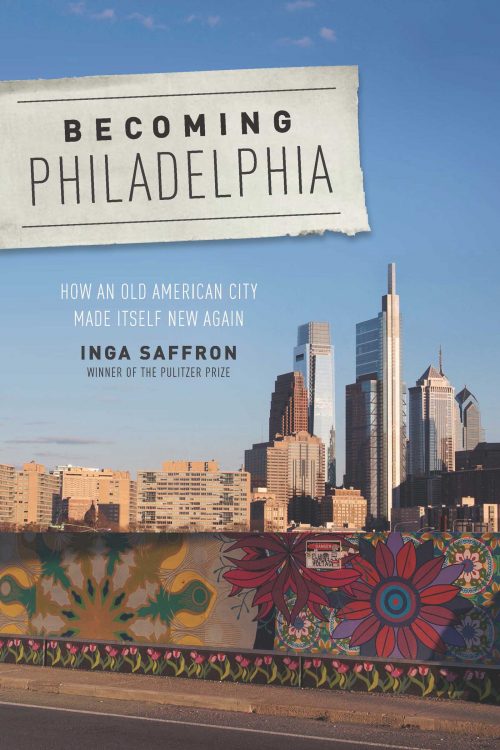
If you’re not already familiar with the work of Inga Saffron, she’s the Pulitzer Prize-winning architecture critic for the Philadelphia Inquirer. In this newly published collection of eighty of her weekly columns selected from the 1,600-plus that she’s written over the last twenty years, Saffron explores the development and changing landscape of Philadelphia during an era of marked revitalization. An era in which a distressed city struggling to survive has been transformed into one that is struggling to manage the gentrification and inequalities brought on by a long-running construction boom.
Saffron, who began writing these columns after a stint as a foreign correspondent in Bosnia and Chechnya, is far more than a critic of architecture. Her columns, hybrids of journalism, history, and strong opinion, trace what she calls “the human cost of development.” What I would say is that she examines the experience of living in Philadelphia from many perspectives, and she does it with striking perspicacity.
The collection is arranged in ten sections, with Saffron’s columns presented chronologically within each of them, touching upon a host of major issues that the city has confronted over the last two decades. Among the issues her columns tackle are affordable housing, congestion and parking, the casinos, I-95 and the Delaware River waterfront, city parks, the experience of pedestrians, bike lanes, the effects of tourism, the controversial 10-year property tax abatement, the unequal distribution of public services, et cetera, et cetera. You get the idea: pretty much everything. And the lens through which she highlights these issues always incorporates her perspective on architecture and design, historic preservation, urban planning and zoning.
To identify just a few specifics, Saffron tells us the stories behind the Barnes Foundation on the Parkway, the Cira Center, the Reading Viaduct, One Meridian Plaza, the failed Penn’s Landing Tram, the Linc, the Convention Center, the abandoned Disneyquest project, the Kimmel Center, the Schuylkill River Trail, the Divine Lorraine Hotel, the invasion of Jewelers’ Row by Toll Brothers, Temple’s proposed football stadium, the Comcast towers, Independence Mall — again, et cetera, et cetera.
Saffron cares deeply about Philadelphia, and her passion for the city is evident in all of her work. “Urban form,” she believes – including the design of public buildings and spaces – “is crucial to the salvation of cities.” Her columns reflect the fact that she is “drawn to ensembles and public spaces for the way they reveal the values and forces that shape culture and civilization.”
Through her eyes, we learn about the city’s urban design policies, how they are shaped by social, cultural, political, and financial forces, and she examines the circumstances in which those policies can become “defeatist,” and can lead to “backward-looking architecture.” In her exploration of the challenges posed by gentrification and historic preservation, she highlights the city’s need for affordable housing and stable “middle neighborhoods” which house the working class and recent immigrants.
In her comprehensive and nostalgic introduction to the book, which looks back upon Philadelphia’s dramatic evolution over the last twenty years, Saffron points out two things about her work that tell you a great deal about her. First, she says: “What has been most heartening for me is that I no longer feel like a lone crank when I write columns about parking garages and skimpy sidewalks.” She also notes: “Looking back, I realize that I may have focused too much on Jane Jacobs-style issues of urban form and not enough on issues of equity.” With respect to the latter point, I think it is true that her voice would be welcome going forward in addressing issues related to poverty and segregation in the city.
Architecture critic, investigative journalist, historian, urbanist, humanist, public citizen, Saffron wears all of these hats, she wears them comfortably, and her highly detailed and opinionated columns are fascinating and satisfying to read. My only criticism of the collection is that for the lay reader it is often difficult to visualize some of the architectural detail she describes. More photographs would have been very helpful in this regard.
Saffron’s column is called “Changing Skyline.” Please take a moment to read her recent column, the online version of which was originally given this title by the editors — “Black Lives Matter. Do Buildings?” Saffron has stated that the column was written in response to the protests in the city which were sparked by “the grotesque killings of George Floyd, Ahmaud Arbery, and Breonna Taylor — and many others before them,” and asks the question: “Does the destruction of buildings matter when black Americans are being brazenly murdered in cold blood by police and vigilantes?”
The print version of this column was initially published under a headline — “Buildings Matter, Too”– which suggested an equivalence between the loss of buildings and the lives of black Americans. The paper subsequently published an apology and changed the online heading of the column to: “Damaging buildings disproportionately hurts the people protesters are trying to uplift.” The top editor of the Inquirer, Stan Wischnowski, resigned in the wake of this series of events.
Becoming Philadelphia
How An Old American City Made Itself New Again
by Inga Saffron
272 pages, 11 b&w images, 6 x 9
Paperback $29.95, Cloth $69.95, EPub $29.95, PDF $29.95
The book has just been published by Rutgers University Press, and can be ordered directly from them at a 30% discount using the code RUPSPRING30.









